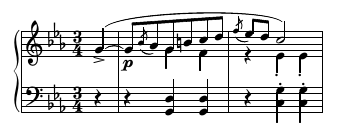Chopin's Mazurkas - Part 4 @ r8
In which I listen to Chopin's Mazurkas and struggle with Lilypond. We begin on Op. 30, No. 1.
Quatre Mazurkas
For à la Princesse de Würtemberg.
Op. 30, No. 1 in C minor
Once again a mazurka starts with a V → i progression.
Truly one of my favorite things in the world.1
The A section ends with a "V of the V" progression and uses
a Picardy third at the end to lead
back nicely to C minor. I talked about the "V of the V" thing and
its prevalence previously in
part 3.
It ends with an interesting
semi-deceptive cadence
by hitting you with a iv before
plagally closing to the i.
Op. 30, No. 2 in B minor
I like the very beginning of this piece. It starts off with a
i → V progression in the first two measures, and then
repeats the same melody but employs an A♮ instead of an A♯ to achieve a
i → v progression.
Since last time I did this I'm always on the lookout for 7♭5 chords, and we've found another in the B section. The B section is mostly a lesson in how the circle of fifths works, but Chopin sneaks in a descending chromatic motif in the left hand to go from C♯7 → F♯m → B7♭5 → E.
I really like these kinds of things because it really emphasizes the importance
of spelling and enharmonics. Tonally it's the same notes with the same frequency,
but in this case the E♯ is very different harmonically from the F♮.
Another reason why I'm not a huge fan of guitar tablature, because you lose
this meaning when you only see, for example, 4 3 on the D string twice
and it's not immediately obvious that the harmony is different since there is no
indication of whether it's an E♯ or an F♮.
In the C section Chopin repeats the idea of the main theme but with different harmonies. The right hand does the same thing four times in a row while the left hand slightly changes the harmony.
This mazurka is unusual in that it ends without gratuitous repeats. It follows an A → B → C → B progression without ever returning to the A section.
Op. 30, No. 3 in D♭ major
Some cool harmonies in this one. I particulary like the reverse (?) Picard Third type thing that occurs at the end of the A section. The piece ends with perhaps a double (?) reverse (?) Picardy third. Meaning, we're in D♭ major, it modulates to D♭ minor, and then hits you with an accented F♮ to re-assert that yes, it is in a major key.
The transition back to the A section at the end of the piece reminds of some Liszt's Sonata in B minor in that there's huge white space interspersed by out-of-key notes, before finally transitioning with full force into something more melodic.
Op. 30, No. 4 in C♯ minor
The intro begins with a little "V of the V" action;
once you notice it one place, it shows up everywhere. Like when you're tired
of losing you car in the parking lot so you buy a new car in a hideous shade
of orange and then immediately discover that everyone already owns an orange
car. Maybe not really like that all, but whatever.
This mazurka has some very Polonaise-like parts to it. Or at least I was reminded of the Military Polonaise with the stocatto chords. Most of the mazurkas have been understated: not using the whole range of the keyboard, and with honestly not a huge amount of dynamic range. This one breaks from the mould a bit with some fortissimos featuring the low end of the keyboard.
Overall I really liked this one. It's one of my favorites so far in this series.
- I've pontificated on this phenomenon extensively in literally every other part of this series.










